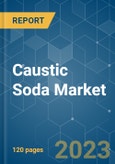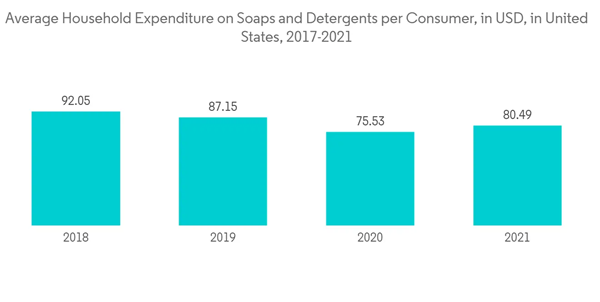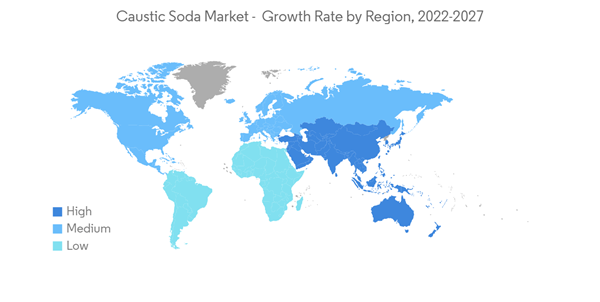During the time frame of the forecast, the caustic soda market is expected to grow at a CAGR of over 5.5%.
The market was negatively impacted by the COVID-19 pandemic in 2020. The coronavirus's impact on demand for chlorine derivatives has squeezed the supply of caustic soda, a by-product of chlorine production. However, the rising prevention due to the spread of COVID-19 increased the demand for soaps, which further propelled the demand for caustic soda, thereby driving the industry's growth.
Asia-Pacific was the leader in the global caustic soda market because of the high demand for making alumina.
During the forecast period, the global market is likely to be driven by all of the above factors.
This product will be delivered within 2 business days.
The market was negatively impacted by the COVID-19 pandemic in 2020. The coronavirus's impact on demand for chlorine derivatives has squeezed the supply of caustic soda, a by-product of chlorine production. However, the rising prevention due to the spread of COVID-19 increased the demand for soaps, which further propelled the demand for caustic soda, thereby driving the industry's growth.
Key Highlights
- Over the short term, one of the major factors driving the growth of the market is the rising demand for alumina in the transport sector and the growing demand for soap and detergent. It is expected that 25% of the aluminum used in transportation will be used in commercial transportation by road and rail.
- Energy-intensive production processes and major environmental concerns are likely to hinder market growth.
- Surging demand for caustic soda in the water treatment industry is expected to offer new growth opportunities for the industry.
Asia-Pacific was the leader in the global caustic soda market because of the high demand for making alumina.
Caustic Soda Market Trends
Increasing Demand from the Soap and Detergent Segment
- Sodium hydroxide (NaOH), also known as lye or caustic soda, is an essential ingredient used in the manufacturing of soaps, cleaners, and detergents. People use sodium hydroxide a lot because it can break up oil, grease, fat, and protein deposits.
- Caustic soda is used in the saponification process that converts vegetable oils into soap. It is used to manufacture anionic surfactants, a crucial component in most detergents and cleaning products.
- Detergents are classified in terms of their ionic properties, namely, anionic, cationic, and non-ionic. The major applications of detergents are reflected in household cleaning and fuel additives.
- Detergent is an effective disinfecting agent. Clothes, unlike other hard surfaces, have layers; hence, viruses can easily settle down on the clothes. Researchers hypothesized that soaking clothes in detergent for a few minutes before washing could aid in virus removal.This, in turn, is increasing the demand for detergent in households.
- In soap production, sodium hydroxide is widely used to manufacture a variety of detergents used in homes and commercial applications. Chlor-alkali products are widely used for manufacturing soaps and detergents. However, due to the COVID-19 crisis, manufacturers worldwide observed a boom in demand for soaps and detergents.
- In 2020, the production volume of detergents will amount to almost 1,515 kilotons in India. India’s per capita consumption of detergent stands at 2.7 kg. The leading players in the Indian detergent market are Henkel, Hindustan Unilever Limited, and Proctor & Gamble. Due to urbanization, there is an increasing demand for better-quality products.
- In the United States, the demand for laundry detergent is growing steadily, which is further projected to accelerate the consumption of caustic soda within the country. In 2021, the average annual expenditure on soap and detergent was $80.49 per consumer.
During the forecast period, the global market is likely to be driven by all of the above factors.
The Asia-Pacific Region to Dominate the Market
- Countries like China, India, Japan, and those in the Association of Southeast Asian Nations (ASEAN) are in the Asia-Pacific region. These countries are expected to grow in the coming years.
- China is both the largest producer and the largest consumer of caustic soda in the world.
- China is the largest pulp and paper-producing country in the world as a result of its large forest reserves (22.5% of its land area).
- China is also a hub for chemical processing, accounting for a major chunk of all chemicals produced globally. With the growing need for both organic and inorganic chemicals around the world, it is expected that the demand for caustic soda from this sector will grow over the next few years.
- India has a surplus of caustic soda because most of its plants are running at more than 85% capacity.
- With the new capacity additions to meet the growing demand from the textile and alumina sectors, the caustic soda industry in India is likely to witness robust growth due to the rise in the number of pulp and paper mills.
- The consumption and production of caustic soda in Japan and ASEAN countries have decreased in the past two years due to maintenance work and reduced demand, but they are expected to grow at a relatively higher pace in the forecast period.
- In the coming years, the demand for caustic soda in the country is likely to go up as the pulp and paper, textile, and chemical processing industries grow.
Caustic Soda Market Competitor Analysis
The caustic soda market is partially fragmented in nature. Some of the key players in the market include Occidental Petroleum Corporation, Shin-Etsu Chemical Co. Ltd, Dow, SABIC, and Formosa Plastics Corporation among others (not in any particular order).Additional benefits of purchasing the report:
- The market estimate (ME) sheet in Excel format
- 3 months of analyst support
This product will be delivered within 2 business days.
Table of Contents
1 INTRODUCTION1.1 Study Assumptions
1.2 Scope of the Study
2 RESEARCH METHODOLOGY
3 EXECUTIVE SUMMARY
4 MARKET DYNAMICS
4.1 Drivers
4.1.1 Rising Demand for Alumina in the Transport Sector
4.1.2 Increasing Demand for Soap and Detergent
4.2 Restraints
4.2.1 Energy-intensive Production Process
4.2.2 Other Restraints
4.3 Industry Value Chain Analysis
4.4 Porter's Five Forces Analysis
4.4.1 Bargaining Power of Suppliers
4.4.2 Bargaining Power of Consumers
4.4.3 Threat of New Entrants
4.4.4 Threat of Substitute Products and Services
4.4.5 Degree of Competition
5 MARKET SEGMENTATION (Market Size in Volume)
5.1 Production Process
5.1.1 Membrane Cell
5.1.2 Diaphragm Cell
5.1.3 Other Production Processes
5.2 Applications
5.2.1 Pulp and Paper
5.2.2 Organic Chemical
5.2.3 Inorganic Chemical
5.2.4 Soap and Detergent
5.2.5 Alumina
5.2.6 Water Treatment
5.2.7 Textile
5.2.8 Other Applications
5.3 Geography
5.3.1 Asia-Pacific
5.3.1.1 China
5.3.1.2 India
5.3.1.3 Japan
5.3.1.4 South Korea
5.3.1.5 Rest of Asia-Pacific
5.3.2 North America
5.3.2.1 United States
5.3.2.2 Canada
5.3.2.3 Mexico
5.3.3 Europe
5.3.3.1 Germany
5.3.3.2 United Kingdom
5.3.3.3 Italy
5.3.3.4 France
5.3.3.5 Rest of Europe
5.3.4 South America
5.3.4.1 Brazil
5.3.4.2 Argentina
5.3.4.3 Rest of South America
5.3.5 Middle-East and Africa
5.3.5.1 Saudi Arabia
5.3.5.2 South Africa
5.3.5.3 United Arab Emirates
5.3.5.4 Rest of Middle-East and Africa
6 COMPETITIVE LANDSCAPE
6.1 Mergers and Acquisitions, Joint Ventures, Collaborations, and Agreements
6.2 Market Share (%)**/Ranking Analysis
6.3 Strategies Adopted by Leading Players
6.4 Company Profiles
6.4.1 BorsodChem (Wanhua Chemical Group Co. Ltd)
6.4.2 Dow
6.4.3 Formosa Plastics Corporation
6.4.4 Grasim Industries Limited
6.4.5 Hanwha Solutions/Chemical Corporation
6.4.6 INOVYN
6.4.7 Occidental Petroleum Corporation
6.4.8 Olin Corporation
6.4.9 SABIC
6.4.10 Shin-Etsu Chemical Co. Ltd
6.4.11 The Sanmar Group
6.4.12 Westlake Chemical Corporation
7 MARKET OPPORTUNITIES AND FUTURE TRENDS
7.1 Future Water Treatment Investments Around the World
Companies Mentioned (Partial List)
A selection of companies mentioned in this report includes, but is not limited to:
- BorsodChem (Wanhua Chemical Group Co. Ltd)
- Dow
- Formosa Plastics Corporation
- Grasim Industries Limited
- Hanwha Solutions/Chemical Corporation
- INOVYN
- Occidental Petroleum Corporation
- Olin Corporation
- SABIC
- Shin-Etsu Chemical Co. Ltd
- The Sanmar Group
- Westlake Chemical Corporation
Methodology

LOADING...










